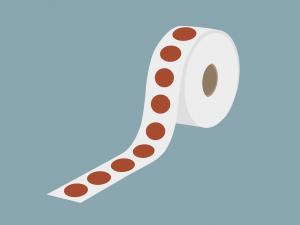Direct to Package Printing: How it’s Streamlining the Digital Process
How do Labels Work?
The typical label designed for product development primarily consists of three main components:
1) Face Stock – the material that is being printed on
2) Adhesive – the sticky section of the material that is directly applied to the face stock
3) Liner – the material the adhesive is applied to
These materials, while used by most companies in the labeling process can be costly over time and take up valuable resources to print and apply.
With the industry moving towards a more eco-friendly and energy saving model – especially with the rise of e-commerce in the wake of Covid-19 – the need for sustainable, quick and easy identification of products continues to grow.
For growing businesses that are thinking of printing labels in house, one way to cut down on time and remain cost effective is to print directly onto the material or packaging they are working with. This allows for packaging without the need for adhesive and label materials, and drastically cuts costs.

High-Res and Eco-Friendly:
Direct to package marking offers higher maximum printing speeds (up to 1000 mm/s) and lower printing costs (about 60% less per 1000 prints). It also allows for variable images and data to be printed in real time, directly on the packaging. No need for labels or label applicators when you print directly to the packaging inline.
Each type of printing process has its pros and cons depending on what it is being used for and how. For instance, adhesive can be peeled off or damaged by friction and humidity. It is also a slower process than direct printing, consuming more resources, supplies, energy, and logistics, as these processes must be carried out separately by different machines.
Direct-to-substrate UV printing is something you may want to look into to boost efficiency while keeping an environmentally friendly impact in the industry.
UV technology is not only ecologically responsible, but is also cost-effective. It is quick, requires no drying time, and allows you to print vibrant, full color images on the side of boxes and other packaging. This technology gives you the freedom and adaptability you need in your print tasks on demand.
Never hesitate to accept a job or consider long lead times since on demand UV printing saves your organization time and money. No more waiting on labels to get your packages out the door, or working with label applicators. Direct UV printing allows you to get your product out the door, faster!
The ability to generate clean, colorful images with little to no setup time is one of the most crucial reasons UV Digital technology is becoming so popular. With the advantages of digital short runs, you may seamlessly transition from one project to the next. Without the limitations of substrates, you can print on almost anything and be confident that the print will be high-quality and bright.
New Sustainable Technology:
New printing technologies like the Limitronic V6 Color have looked at packaging in a different way, streamlining the printing process by copying a design directly on the container the product is in. This not only saves on time it also saves money; foregoing the need for adhesive and extra label materials that can be costly overtime.
 A label being made by the ArrowJet Aqua 330R
A label being made by the ArrowJet Aqua 330R
These new direct-to-print technologies give businesses much more control in their printing processes so buyers will end up making quite a bit more on their initial return. These printers can be freely integrated into any type of automated engineering, and can print in all directions, thus adapting to the characteristics of each company depending on their needs.
The process to print more ethically sourced material is clearly changing. Some printing technologies use water-based pigmented ink to create the desired effect. The ArrowJet Aqua 330R for instance uses water-soluble dies to make a difference with the ever changing food packaging standards, and are a perfect way to cut back on some of the negative effects some inks can have on the environment.
Transitioning to a more eco-friendly printing process is a great way to market a product, while also making it known you’re just as attuned to reducing your company’s carbon footprint as you are to the needs of your customer base. Direct to packaging printing can help you do that, cutting down on time and costs while remaining environmentally friendly.
Understanding the impact direct to package printing has on a company can be difficult. To see how it can work for your business, contact our knowledgeable sales staff today for a FREE consolation and we’ll help find the perfect solution for your packaging needs.
